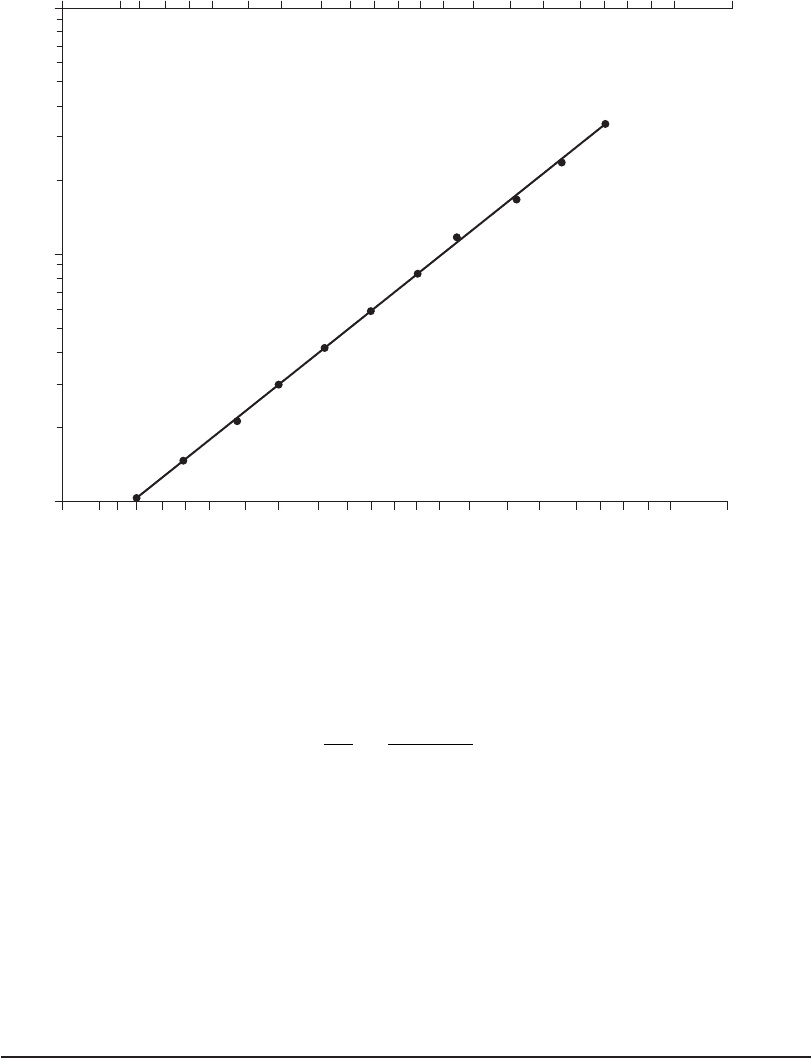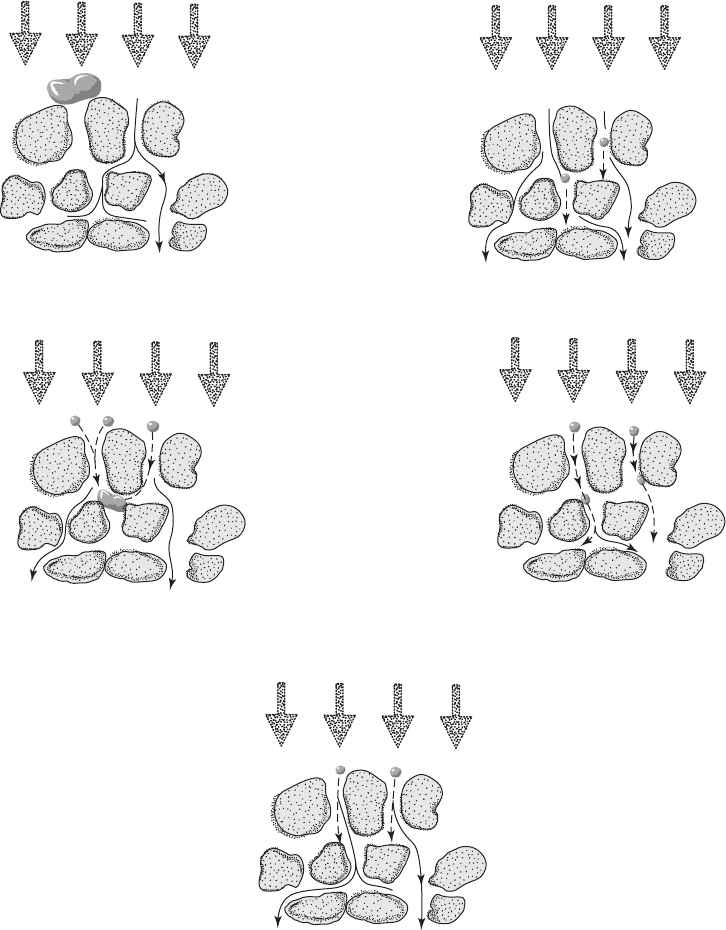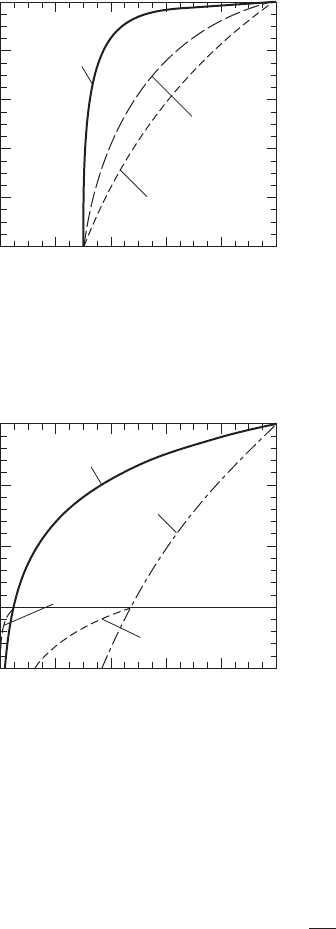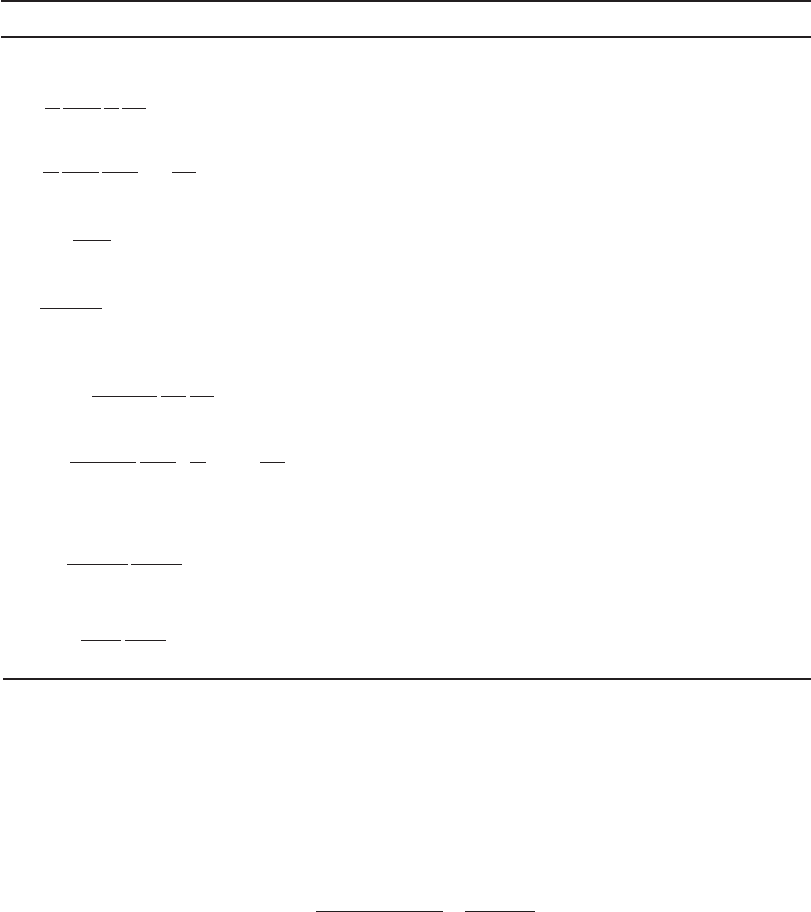Water and Wastewater Engineering
Подождите немного. Документ загружается.


11-6 WATER AND WASTEWATER ENGINEERING
establis hes the following relations between the effective size, uniformity coefficient, geometric
mean size, and geometric standard deviation:
EP XS
10
()()
gg
1.28
(11-1)
UPP S
g
60 10
1 535
/()
.
(11-2)
S a n d excavated from a natural deposit is called run-of-bank sand. Run-of-bank s and may
be too coarse, too fine, or too nonuniform for use in filters. Within economic al limits, proper
sizing and uniformity are obtained by screening out coarse components and washing out fine
co
mponents. In rapid sand filters, the removal of “fines” may be accomplished by stratifying
the bed through backwashing and then scraping off the layer that includes the unwanted sand.
In the United States, filter sand is purchased from commercial suppliers based on
specifications
provided by the engineer rather than processing the sand at the point of use.
Physical Properties
Standard requirements for filter media are described in ANSI/AWWA stand ard No. B100-01
(AWWA, 2001). This discussion is to highlight some of the properties.
Hardness. Hardness of the filter material is important as it is an indicator of the resistance to
abrasion and wear that occurs during filter backwashing. Hardness is ranked on the Moh scale.
Talc ha
s a Moh hardness number of 1. Diamond has a Moh hardness number of 10. Sand, garnet
and ilmenite * are hard enough to resist abrasion. Anthracite coal and granular activated car-
bon (GAC) are friable and design specifications must specify the minimum acceptable hardness
value. A mini
mum Moh hardness of 2.7 is often specified for anthracite (MWH, 2005). GAC
hardness is evaluated using ANSI/AWWA standard B604-96 (AWWA, 1996).
Porosity. The porosity of the in-place media (not of the individual grains) affects the headloss
and filtration efficiency of the media. It is defined as
Tv
V VV
T
V
T
V
M
(11-3)
where porosity, dimensionless
volume
v
V
of voids, m
3
total
T
V
v o l ume of media bed, m
3
volum
e
V
M
of media, m
3
Specific Gravity. The specific gravity of the media plays a role in both the arrangement of the
filter media in multimedia filters and in the backwash flow requirements that are required to flu-
idize the bed. The selection of the media used in the design of dual- and tri-media filters is based
on the specific gravity of the m
edia.
* Garnet i s a generic term referring to several minerals that are silicates of iron, aluminum, and calcium mixtures. Ilmenite is an
iron-titanium ore associated with hematite and magnetite, which are iron oxides.

GRANULAR FILTRATION 11-7
Summary. Typical properties of filter media are summarized in Table 11-1 . Smaller effective
sizes than those shown result in a product water that is lower in turbidity, but they also result in
higher pressure losses in the filter and shorter operating cycles between each cleaning.
E xample 11-1 illustrates how the media is tested to meet effective s
ize and uniformity coef-
ficient requirements.
Example 11-1. A sand filter is to be des igned for the Ottawa Island’s new water treatment
plant. A sieve analysis of the local island sand is given below. Using the sand analysis, find the
effective size, E, and uniformity coefficient, U.
U. S. Standard
Sieve No.
Analysis of Stock Sand
(Cumulative Mass % Passing)
140 0.2
100 0.9
70 4.0
50 9.9
40 21.8
30 39.4
20 59.8
16 74.4
12 91.5
8 96.8
6 99.0
Solution. Begin by plotting the data on log-probability paper as shown in Figure 11-3 . From
this plot, find the effective size:
EP
10
0 30. mm
Property
Anthracite
coal GAC Garnet Ilmenite Sand
Effective size, mm
0.45–0.55
a
0.8–1.0 0.2–0.4 0.2–0.4 0.3–0.6
0.8–1.2
b
Uniformity coefficient
1.65
a
1.3–2.4 1.3–1.7 1.3–1.7 1.3–1.8
1.85
b
Hardness, Moh 2–3 very low 6.5–7.55–6 7
Porosity 0.50–0.60 0.50 0.45–58 N/A 0.40–0.47
Specific gravity 1.5–1.75 1.3–1.7 3.6–4.2 4.2–5.0 2.55–2.65
Sphericity 0.46–0.60 0.75 0.60 N/A 0.7–0.8
TABLE 11-1
Typical properties of filter media
a
When used alone.
b
When used as a cap on a dual media filter.
Sources: Castro et al., 2005; Cleasby and Logsdon, 1999; GLUMRB, 2003; MWH, 2005.

11-8 WATER AND WASTEWATER ENGINEERING
The uniformity coefficient is then
U
P
P
60
10
085
0 30
28
.
.
.
mm
mm
Comments:
1 . Obviously, this sand does not fall within the prescribed limits. Although this sand could
be processed to meet the specifications, in the United States the sand would be rejected
and the supplier would be required to provide a replacement.
2. Probability paper is not req
uired to determine E and U. The x -axis scale may be arithme-
tic or any other scale that allows a smooth curve to be drawn through the data so the d
10
and d
60
sizes can be determined.
3. A spreadsheet plot with a curve fitting function is very useful in selecting the plotting
axis and determination of the d
10
and d
60
sizes.
0.01
0.10
1.0
10.0
99.99 99.9 99.5 99 98 95 90 80 70 60 50403020 10 5 210.5 0.1 0.01
0.1 0.2 1 2 5 10 20 3040
Cumulative mass percent passin
g
Sieve size, mm
506070 80 90 95 98 99 99.8 99.9 99.99
FIGURE 11-3
Grain size analysis of run-of-bank sand.
GRANULAR FILTRATION 11-9
11-4 GRANULAR FILTRATION THEORY
Mechanisms of filtration
A s shown in Figure 11-4 a, some particles are removed by simple mechanical screening because
the particle is larger than the smallest opening through which the water flows. This is the domi-
nant mechanism for slow sand filters. Straining causes a cake to form at the surface of the filter.
This improve
s the efficiency of particle removal but also increases the headloss.
In depth-filtration, particles smaller than the openings between the granular material are removed
by a variety of mechanisms including sedimentation, flocculation, interception, and impaction.
The pore spaces between the grains of granular material are small, and the water velocity
through the intersti
ces is also small. If the mass and diameter of the particles is large enough,
it will settle through the short distance from the water to the particle ( Figure 11-4b) . Because
the streamlines of water flowing through the interstices bend as the water passes around the
granular material, particles are brought into contact with one another. This mix
ing causes them
to flocculate and grow larger in size ( Figure 11-4c) . The larger particles may then be captured
by straining. Bending streamlines also cause smaller particles to pass near enough to the grains
of filter material to be intercepted ( F igure 11-4d) . In some cases the particles have suffic
ient
mass that they cannot follow the alteration in flow path with the streamlines, and their trajectory
causes them to impact on the granular material of the filter ( Figure 11-4e) .
A s the particles in the water come in contact with the granular filter material, the surface
forces must be favorable for them to attach. They must sufficiently destabilized so that the ele
c-
trostatic repulsive forces are minimized and the short range van der Waals forces res u lt in a net
attractive force.
Two approaches are used to provide models of fundamental filtration theory: microscopic
and macroscopic (or phenomenologic). Although these models
are not effective for predicting
long-term filter performance, they are useful for evaluating the relative importance of the filtra-
tion mechanisms and the importance of several design and operating parameters. The models are
based on several simplifying assumptions: spherical particles collide with spherical filter grains;
hydrody
namic variability caused by angular media is not considered; changes in the filter media
with time and depth in the filter are not considered; and changes in porosity and grain size as
particles accumulate are not considered.
Microscopic Models of Filtration. Yao et al. (1971) developed a transport and attachment model
that
describes accumulation of particles on a single media grain “collector” by sedimentation, inter-
ception, and diffusion. This model underpredicts the number of collisions when compared to experi-
mental data. A refinement of this model, called trajectory analysis, b y Rajagopalan and Tein (1976)
inc
ludes additional attractive forces due to van der Waals forces and reduced collisions due to viscous
resistance. This model predicts filtration behavior better than the Yao model (Logan et al., 1995).
The Rajagopalan and Tien model can be used to demonstrate the effect of the uniformity
c
oefficient ( Figure 11-5 ) and dual-media filters ( Figure 11-6 ) on filtration efficiency.
Macroscopic Models of Filtration. The phenomenological models make no attempt to de-
scribe the mechanisms of particle transport or attachment. They are based on a m ass balance
expression and an empirical rate expression to relate the duration of ripening, water quality, time
to breakthrough, and time to terminal headloss.

11-10 WATER AND WASTEWATER ENGINEERING
(a) (b)
(c) (d)
(e)
FIGURE 11-4
Mechanisms of granular filtration: (a) mechanical screening, (b) sedimentation, (c) flocculation, (d ) interception,
(e) impaction. Dashed line is particle trajectory. Solid line is water streamline (flow path).

GRANULAR FILTRATION 11-11
The rate expression describes a first-order removal with depth proportional to the local par-
ticle concentration in the water:
C
z
C
(11-4)
where C concentration of particles in suspension, mg/L
filter coefficient, m
1
z depth in filter, m
Based on laboratory and pilot scale studies, the filter coefficient is inversely proportional to the
filtration rate, grain size, and the square of the viscosity (Cleasby and Logsdon, 1999).
0.0
1.0
0.8
0.6
Depth, m
0.4
0.2
0.0
0.2 0.4
Filtrate quality, C/C
o
Natural sand
E = 0.44,
U = 3.0
Filter sand
E = 0.50,
U = 1.35
Monodisperse sand
E = 0.61, U = 1.0
0.6 0.8 1.0
FIGURE 11-5
Effect of media uniformity on solids penetration in
filter bed.
( Source: MWH, 2005.)
0.0
2.0
1.5
1.0
Depth in filter, m
0.5
0.0
0.2 0.4
Particle concentration, C/C
o
Monomedia,
␣ = 1
Monomedia,
␣ = 0.25
Dual media,
␣ = 1
Dual media,
␣ = 0.25
Anthracite
sand
0.6 0.8 1.0
FIGURE 11-6
Effect of attachment efficiency on effluent from
monomedia and dual-media filters.
( Source: MWH, 2005.)

11-12 WATER AND WASTEWATER ENGINEERING
The mass balance for a differential element may be expressed as
t
C
z
v
a
(11-5)
where specific deposit
mass of accumulated particles per filter bed volume, mg/L
v
a
filtration rate, m
3
/ s · m
2
of filter surface area, also m/s
t time, s
B y combining Equations 11-4 and 11-5 , the basic phenomenological model is
t
v C
a
(11-6)
A simplified steady state model allows the computation of the time to breakthrough ( t
B
) and
the time to the limiting head ( t
HL
):
t
D
v CC
B
B
aE
()
0
(11-7)
t
H hD
kvCC
HL
TL
HL a E
()
()()( )
0
(11-8)
where
B
specific deposit at breakthrough, mg/L
D depth of filter bed, m
C
0
influent concentration of particles, mg/L
C
E
effluent concentration of particles, mg/L
H
T
limiting head, m
h
L
initial clean bed headloss, m
k
HL
headloss rate constant, L · m/mg
A regression analysis of data collected from actual or pilot filters is used to estimate
B
and k
HL
.
With these “constants,” the length of the filter run and the time to reach terminal headloss can be
estimated. In addition, with pilot data, the optimum filter depth and run time can be estimated for
a given solids loading.
11-5 THEORY OF GRANULAR FILTER HYDRAULICS
The hydraulic issues to be considered in the design of a filter system include: headloss through a
clean filter bed, headloss resulting from the accumulation of particles in the bed, the fluidization
depth of the bed during backwashing, and headloss in expanding the filter bed.
Clean Filter Headloss
Although the equations describing headloss are limited to clean filter beds, they provide an oppor-
tunity to examine the initial stages of filtration and the effects of design variables on headloss.
A number of equations have been d eveloped to d escribe the headloss of clean water flow-
ing through a clean porous medium, such as a granu
lar filter. Several of these are summarized in
Table 11-2 . These are derived from the Darcy-Weisbach equation for flow in a closed conduit and

GRANULAR FILTRATION 11-13
Equation Definition of terms
Carmen-Kozeny (Carmen, 1937)
h
fL
dg
L
a
1
3
2
h
L
g
p
d
L
a
g
=
11
3
2
f
f
150
1
175
R
.
R
d
a
Fair-Hatch (Fair and Hatch, 1933)
h kvS
L
d
g
L
a
2
2
3 2
1()
hkv
L
g
p
d
L
a
g
()16
2
3
2
2
⎛
⎝
⎜
⎞
⎠
⎟
∑
Ergun (1952a)
hk
L
gd
Lv
a
()1
2
3 2
k
Lv
gd
i
a
1
3
2
−
d grain size diameter, m
f friction factor
g acceleration due to gravity, 9.81 m/s
2
h
L
headloss, m
k filtration constant, 5 based on sieve
openings, 6 based on size of separation
k
headloss coefficient due to viscous forces,
dimensionless
k
i
headloss coefficient due to inertial forces,
dimensionless
L depth of filter bed or layer, m
R Reynolds number
p fraction of particles (based on mass)
within adjacent sieve sizes
S shape factor (varies between 6.0 for
spherical particles and 8.5 for crushed
materials)
a
superficial (approach) filtration
velocity, m/s
porosity
viscosity, Pa · s
kinematic viscosity, m
2
/s
density of water, kg/m
3
particle shape factor (1.0 for spheres, 0.82
for rounded sand, 0.75 for average sand,
0.73 for crushed coal and angular sand)
TABLE 11-2
Formulas used to compute the clean-water headloss through a granular porous medium
dimensional analysis. The Carmen-Kozeny, Fair-Hatch, and Rose equations are appropriate for
sand filters when the Reynolds number does not exceed 6. For larger filter media, where higher
velocities are used, the flow may be in the transitional range where these equations are not adequate.
The Ergun equation is recommended for these ca
ses (Cleasby and Logsdon, 1999).
The headloss through a clean stratified-sand filter with uniform porosity described by Rose
(1945) serves as an example for illustration:
h
vD
g
L
a
1 067
2
4
.()()
()()()
(C
D
)(f )
∑
d
g
(11-9)
where h
L
frictional headloss through the filter, m
v
a
approach velocity (also known as face velocity, filtration rate, or loading rate ),
m/s (or m
3
/ s · m
2
of surface area)
D depth of filter sand, m
C
D
drag coefficient

11-14 WATER AND WASTEWATER ENGINEERING
f mass fraction of sand particles of diameter, d
g
d
g
geometric mean diameter of sand grains, m
shape factor
g acceleration due to gravity, m/s
2
porosity
The drag coefficient is defined in Equations 10-10 and 10-11 . The Reynolds number is used
to calculate the drag coefficient. The sand grain diameter is multiplied by the shape factor to
a ccount for nonspherical sand grains. The su mmation term is inc
luded to account for stratifica-
tion of the sand grain sizes in the filter. The size distribution of the sand particles is found from a
sieve analysis. The mean size of the material retained between successive sieve sizes is assumed
to correspond the geometric mean size of successive
sieves. It is calculated as
ddd
g
()
12
0 5.
(11-10)
where d
g
geometric mean diameter of grain size distribution between sieves, mm
d
1
, d
2
diameter of upper and lower sieve openings, mm
A cursory examination of the Rose equation reveals the following important relationships:
• The headloss is directly proportional to the square of the filtration or loading rate (m
3
of
water/d · m
2
of filter surface area or m/d or m/h), so small increases in loading rate are
amplified.
• Headloss is inversely proportional to the diameter of the sand grains.
• The porosity, which is assumed constant through the bed, plays a very strong inverse role
in the headloss.
From a design point of view, given the des
ign flow rate ( Q ), the filtration rate ( v
a
) may be
adjusted by adjusting the surface area of the filter box. The sand grain size distribution is speci-
fied by the effective size and uniformity coefficient. The headloss can be reduced by limiting the
amount of fines in the distribution of sizes.
The porosit
y of the sand plays a significant role in controlling the head loss, and it is not in
the control of the designer. Although other media, such as anthracite coal, provides an alternative
means of adjusting the porosity, the range of porosities is not great. A further confounding fac-
tor is that all the headloss equations assume a uniform porosity thro
ugh the depth of the bed—an
unlikely occurrence once the bed is stratified.
A subtle but important variable that is not evident from a cursory examination of the equa-
tion is that of the water temperature. The viscosity is used in calculating the Reynolds number
and it, in turn, is a function of the water temperature.
E xam
ple 11-2 illustrates the computation of the clean bed headloss for a stratified sand filter.
Example 11-2. Estimate the clean filter headloss in Ottawa Island’s proposed new sand filter
using the sand described in Example 11-1 , and determine if it is reasonable. Use the following
assumptions: loading rate is 216 m
3
/ d · m
2
, specific gravity of sand is 2.65, the shape factor is 0.82,
the bed porosity is 0.45, the water temperature is 10 C, and the depth of sand is 0.5 m.

GRANULAR FILTRATION 11-15
Solution. The computations are shown in the table below.
Sieve no. % Retained
d, m
R
C
D
∑
()()Cf
d
D
8–12 5.3 0.002 3.1370 9.684551256.64
12–16 17.1 0.00142 2.2272 13.12587 1,580.7
16–20 14.6 0.001 1.5685 18.03689 2,633.4
20–30 20.4 0.000714 1.1199 24.60549 7,030.1
30–40 17.6 0.000505 0.79208 34.01075 11,853
40–50 11.9 0.0003570.55995 47.21035 15,737
50–70 5.9 0.0002520.39526 60.72009 14,216
70–100 3.1 0.000178 0.27919 85.96328 14,971
100–140 .7 0.000126 0.19763 121.4402 6,746.7
Total (C
D
)(f)/d
75,025
In the first two columns , the grain size distribution from Example 11-1 is rearranged to show
the fraction retained between sieves. The third column is the geometric mean diameter of the
sand grain compu ted from the upper and lower sieve size. The fourth column is the Reynolds
number comp
uted from Equation 10-9 with the correction for nonspherical sand grains. For the
first row,
R
()()( )
()( )( )
dv
a
0 82 0 002 0 0025
1
.. .
.
mm/s
3307 10
3 137
6
m /s
2
.
The filtration velocity of 0.0025 m/s is the conversion of the filtration loading rate to compatible
units:
v
a
216
86 400
0 0025
3 2
m /dm
s/d
m/s
,
.
The kinematic viscosity is determined from Appendix A using the water temperature of
10 C. The factor of 10
6
is to convert from m
2
/ s to m
2
/ s.
The drag coefficient is calculated in column 5 using either Equation 10-10 or 10-11 , depend-
ing on the Reynolds number. For the first row,
C
D
24 3
0 34
76507 1 693 8034 9 6846
12
R
R
/
.
....
The final column is the product of the fractional mass retained and the drag coefficient divided
by the diameter. For the first row,
()()
()()
Cf
d
D
9 6846 0 053
0 002
25664
1
..
.
. m
